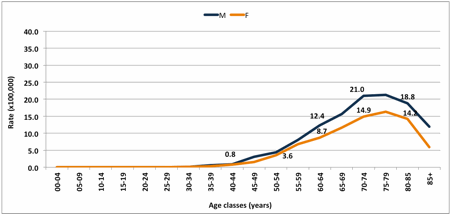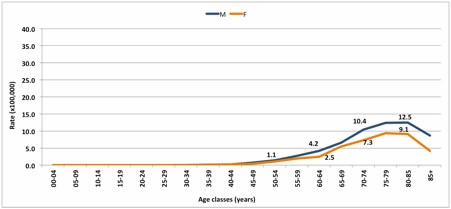Abstract
Introduction. The incidence of multiple myeloma (MM) is increasing in particular due to the aging of the population.In the last 15 years, stem cell transplantation and novel agents have increased the remission rates and improved survival. The aim of the present work is to assess the epidemiologic burden of treated patients from population-based data.
Methods. The Regional Health Service (RHS) of Lombardy covers around 10 million people. Administrative datasets available within the Lombardy RHS included: demographic data, hospital discharges, pharmaceutical prescriptions, and outpatient claims. Since 2000 these archives were organized into a data warehouse named DENALI. A distinguishing feature of DENALI is the probabilistic reconstruction of links to match the data of different datasets belonging to the same person. The initial study population was selected from DENALI and involved all those individuals who during the period 2003-2009 had at least one hospital discharge for MM and at least one MM specific drug prescription among melphalan, bortezomib, cyclophosphamide, thalidomide, doxorubicin, and lenalidomide. The first hospital discharge or drug prescription date whichever occurred first was identified as the index date. From the initial population we excluded individuals with a diagnosis of cancer prior to the index date to avoid overlapping oncological diagnoses, and also those who did not receive chemotherapy (CHT) to focus on patients with symptomatic MM. The study population was followed up until 31-Dec-2010 or death. We evaluated clinical and demographic characteristics, incidence and mortality of the selected MM patients.Age was estimated at the index event and reported in years with corresponding minimum and maximum range. Comorbidity conditions were synthetized by Charlson Comorbidity Index (CCI) on diagnoses of hospital discharges occurred before the index date. Crude incidence was estimated with respect of Lombardy inhabitants and expressed x100,000 of them, as the corresponding 95% Confidence Intervals (95%C.I.). Age-adjusted incidence was estimated using the 2001 standard population proposed by the World Health Organization (WHO). Relative survival ratios (RSRs) were computed as measure of survival.
Results. A total of 3,043 eligible subjects was identified (52% male). Median age(min-max) at the index date was 67.4 (26.9-92.3) years in male and 69.8 (17.5-96.8) in female patients. CCI showed high comorbidity component (CCI>=2) in 10% and 6% of male and female individuals, respectively. Crude incidence and mortality rates were reported in Figure 1 and Figure 2. Crude and age standardized incidence was respectively 4.9 and 3.7 for males and 4.4 and 2.7 for females. Crude and age standardized mortality rates were respectively 2.2 and 1.6 for males and 2.0 and 1.1 for females. Within the study population, 1- and 5-year RSRs (95% C.I.) were 85%(83-86%) and 49%(46-51%), respectively, with no significant differences between genders. Thirty-seven percent of the study population had at least one prescription of the novel agents for MM (bortezomib, lenalidomide, and thalidomide). Thirty percent of the study population had a Stem Cell Transplantation (SCT): they had a median age(min-max) of 60.2(21.7-75.4), low comorbidity score(CCI=0) in 90% of them and 1- and 5-year RSRs equal to 98%(97-99%) and 70%(66-74%), respectively. Seventy percent of the study population received CHT but not SCT: their median age(min-max) was 72.6(17.5-96.8), 74% of them had CCI=0 and 1- and 5-year RSRs equal to 78%(76-80%) and 39%(35-41%), respectively.
Treated but not transplanted patients have been estimated to experience a significant (p<1%) higher mortality compared to those transplanted, even taking into account age and sex.
Conclusions. This population-based cohort study along with the availability of administrative databases enabled us to detail a reliable picture of symptomatic MM in a real life context.
Crude incidence rates by age class and gender, expressed x 100,000 Lombardy inhabitants.
Crude incidence rates by age class and gender, expressed x 100,000 Lombardy inhabitants.
Crude mortality rates by age class and gender, expressed x 100,000 Lombardy inhabitants.
Crude mortality rates by age class and gender, expressed x 100,000 Lombardy inhabitants.
Mantovani:Janssen: Research Funding. Rossi:Janssen: Consultancy.
Author notes
Asterisk with author names denotes non-ASH members.



This feature is available to Subscribers Only
Sign In or Create an Account Close Modal